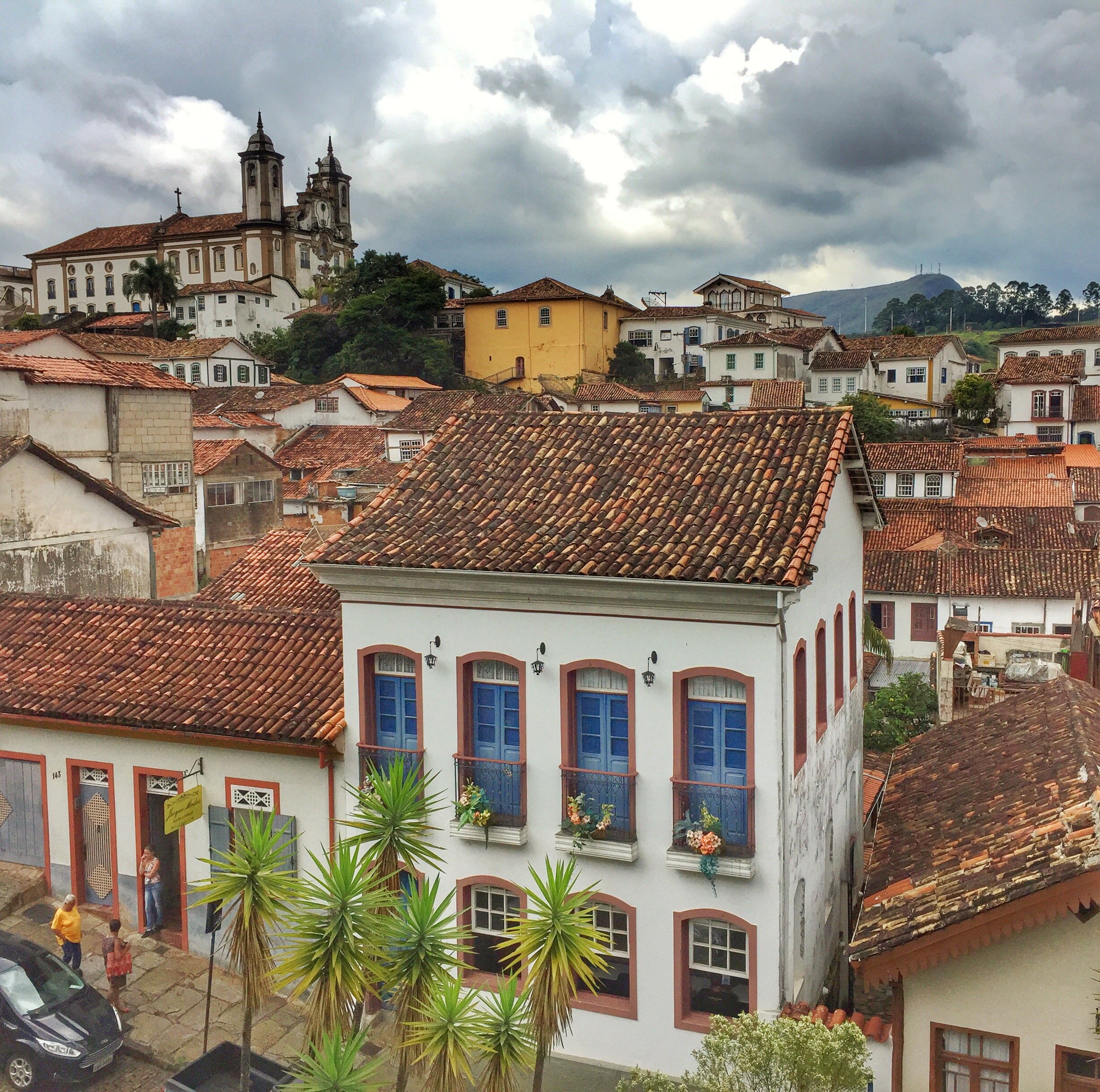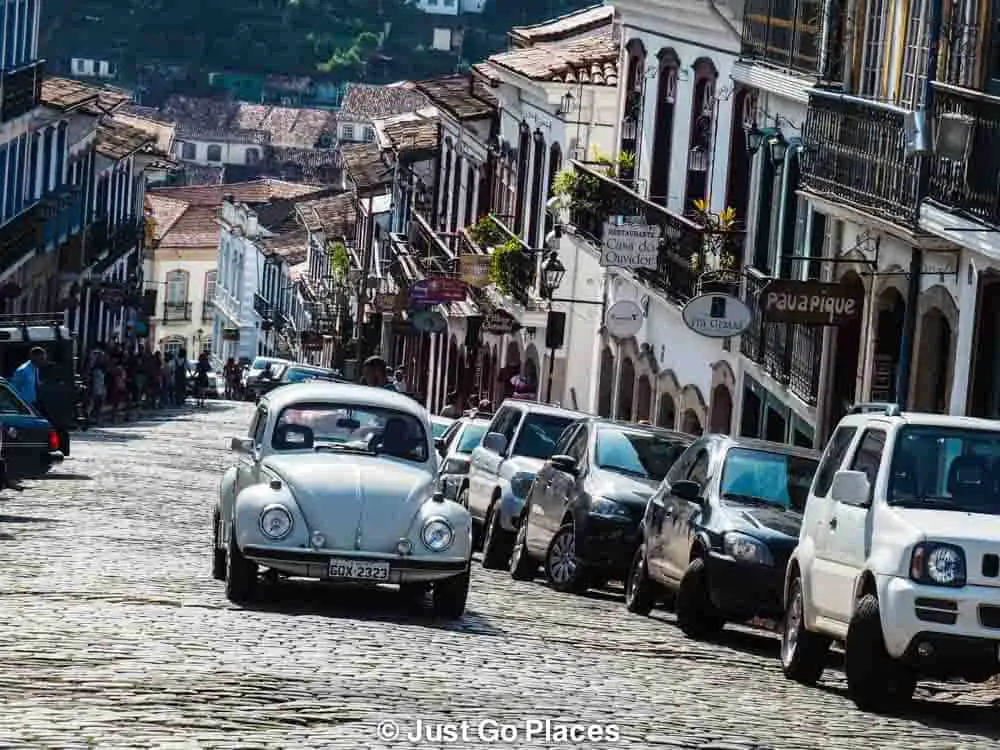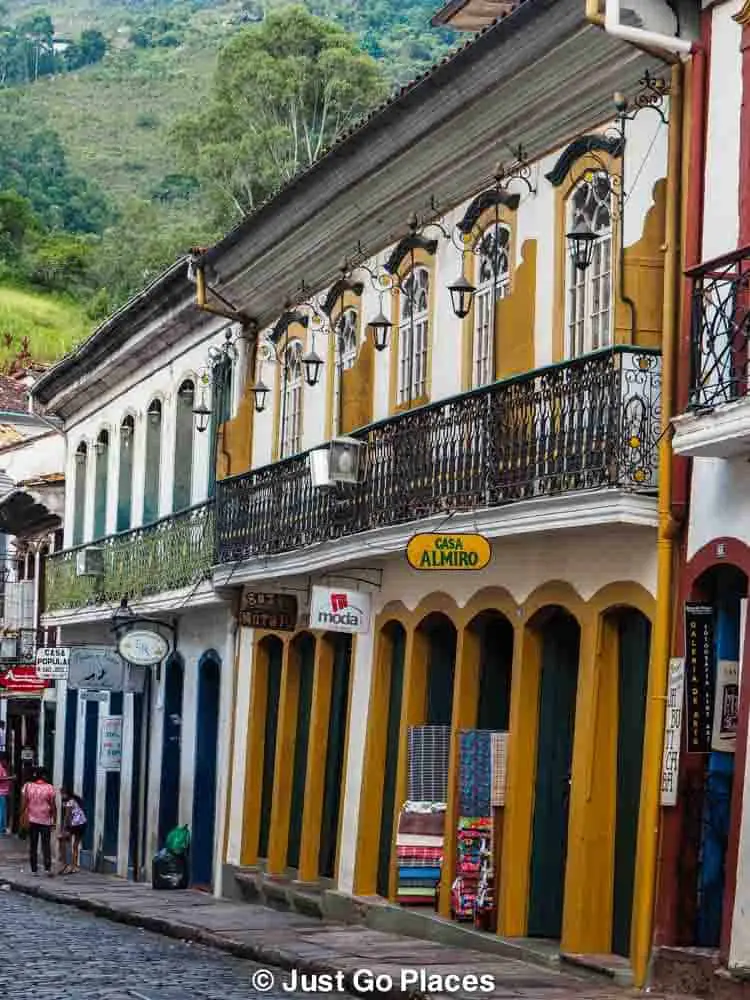Through our open windows we could hear the chirping of the Maritaca parrots over the rattling of cars on the cobblestone streets. The summer rain pelting off the tiled roofs, the clanging of church bells and the chatter of university students out carousing added to the ambient noise of the town. Ouro Preto, Brasil, is a perfectly preserved version of its former glory as the centre of the country’s gold rush. This historical place in Brazil received its UNESCO world heritage status in 1980. From our hotel room in the historical centre of town, I can tell you the city is pretty but it’s definitely not quiet and neither does it have a pretty past.
Ouro Preto Brasil was the capital of the province, Minas Gerais, for over 150 years. Minas Gerais (translated as “general mines”) was exploited by the Portuguese for its mining wealth using slave labor. Although better off than their slaves, the Portuguese miners also felt hard done by the Portuguese government who taxed their profits heavily. When you are in the area, you can take a gold mine tour in Ouro Preto to better understand the conditions that made this area a UNESCO world heritage site.
Contents
Ouro Preto Brasil
Founded in 1696, Ouro Preto is the oldest town in the state of Minas Gerais. Ouro Preto became incredibly wealthy from gold mining in the 18th century and the largest city in South America.
Ouro Preto (which means black gold) was at the epicentre of the Brasilian gold rush. The area’s gold is a distinctive darker colour thanks to the deposits of palladium and iron ore in the area.
A Forgotten Interior
In the 17th century, the Portuguese considered Brasil a somewhat hellish place. They stuck to settling the coasts and imported slaves from Africa. These slaves though tended to run away (usually into the forested interior of the country). The interior had any number of dangers – wild animals, disease and indigenous tribes of cannibals.
Slave hunters (bandeirantes) were dispatched to retrieve escaped slaves. When the slave hunters got to Ouro Preto though they discovered gold. This gold, much more profitable than slave hunting, was plentiful and easily accessible. Pretty soon Ouro Preto became a Brasilian gold rush town.
The Gold Rush Cometh
People would show up, pitch their camp and start digging. The town grew haphazardly because people were just out for gold. No thought of town planning came into play. The houses were mainly in the valley because the gold would be brought downstream by the water. 
A Major Historical Place in Brazil
The capital at the time may have been Rio de Janeiro but the money came from Ouro Preto. The Portuguese King when he fled Napoleon in the 19th century settled in Rio. The King made a point of visiting Ouro Preto though. He had been escorted to Brasil under the protection of the British Navy. Britain was paid for their troubles with Ouro Preto gold. In fact, Ouro Preto gold paid for a lot of the Portuguese crowns debts.
To this day every April 21st, Ouro Preto gets to be the capitol of Brasil for a day.
Mining & Slavery in South America
The history of slavery in South America isn’t as widely discussed as the history of slavery in the United States. Brazil was a major destination in the history of slavery in South America because there was lots of land to cultivate and natural resources to exploit.
Slavery in South America is all about the lack of manual labor needed to work the land. White European settlers could show up and buy land cheaply. The native Americans would escape back into the jungles or die of disease when Europeans tried enslaving them. Most African slaves, forcibly relocated across an ocean and divested off their family ties, had no choice but to work.
The Portuguese directly transported slaves from Africa to work on the plantations and the mines. The Spanish hired other nationalities to be their slave traders.
Of the approximately 10 million slaves sent to the Americas, almost 40% went to Portuguese American colonies of which Brazil was the crown jewel. You could say that the majority of slavey in South America happened in Brazil.
Some African slaves did escape though and went deep into the hinterland of Brazil. The Portuguese would hire slave hunters (bandeirantes) to search for and bring back runaway slaves. Ouro Preto was discovered by accident when the slave hunters went looking for slaves and found gold instead.
When the easy access to the gold in the streams ran out, the Portuguese brought in slaves to dig mines which was hard back-breaking manual labor. By the time that Brazil got its independence, half the population were slaves!!
The Discontent of the Miners
It wasn’t just the slaves who suffered under the Portuguese desire for gold. Ouro Preto was the site of a miner’s revolution which was an early attempt at independence for Brazil. The miners were angry at Portuguese taxes placed on their mining (sound familiar to Americans and the Boston Tea Party).
The mining revolt’s leader, Joaquim Jose da Silva Xavier (popularly known is Tiradentes (or “tooth puller” for being an early day dentist) was brutally executed in the town plaza of Ouro Preto as a deterrent to other would-be revolutionaries. Tiradentes plaza is now a main square of Ouro Preto.
Ouro Preto’s Immense Wealth
Golden Churches
Always religious, the Portuguese built chapels and churches to thank God for their luck. Ouro Preto has 13 churches and 8 chapels. Hence, one of the prevalent sounds in town are church bells. I was told that the people of Minas Gerais are still more religious than the rest of Brasil.
All those churches and chapels needed to be decorated. No minimalist Protestantism for the Portuguese!
Artists and Craftsmen
This work brought in master craftsman and artists to the town. They painted, carved and spackled gold leaf like nobody’s business. The Portuguese traded with the Spaniatds for silver because Brasil doesn’t have silver resources of its own. They traded 2 kilos of gold for 1 kilo of silver!!!

The town still has maintained this artistic heritage, too. There are lots of art galleries in town.
Colonial Architecture
The old town is perfectly preserved. The newer buildings are hidden out of site to maintain the 19th century ambience.
 We found a lot of Volkswagon Beetles in town. They are cheap (about US $1000), sturdy and easy to fix. There are plenty of spare parts available. Even though the cobblestones are pretty, they are tough on cars. I thought the VW bugs fit in perfectly with the town’s old-fashioned charm.
We found a lot of Volkswagon Beetles in town. They are cheap (about US $1000), sturdy and easy to fix. There are plenty of spare parts available. Even though the cobblestones are pretty, they are tough on cars. I thought the VW bugs fit in perfectly with the town’s old-fashioned charm.
You can see how steep these hills are. Walking through the town is actually pretty good exercise especially in the heat!!
The pretty colours of the buildings are set by the authorities to reflect period colours. I guess they don’t want a yellow and green Brasilian flag house!
Universities and Museums
The town is also home to a university with the distinction of having the first engineering school in the Americas. (After the initial easy pickings, the Portuguese used slaves to mine for gold).
High Culture
All that money brought culture too. Ouro Preto has the oldest opera house in the Americas too. It’s beautifully maintained and still in use today.
Taking A Gold Mine Tour in Ouro Preto
A gold mine tour will show you the origins of Ouro Preto’s immense wealth. And, the conditions in which African slaves hacked away at rock by hand to create immense wealth for others.
Mina Chico Rei
Mina Chico Reioffers gold mine tours in Ouro Preto. There’s actually not much to see inside the gold mine but my children enjoyed the mine track ride down into the mine.
Mina da Passagem
Mina da Passagem near Ouro Preto is famous for being transferred for a century from Portugal to Great Britain to pay off its debts in the 19th century. The Passage Ouro Preto mine was opened in 1719 and is the world’s largest gold mine open to the public.
SPREAD THE WORD! PIN THIS TO YOUR TRAVEL PINTEREST BOARDS FOR FUTURE REFERENCE!
We did not receive compensation of any form, monetary or otherwise, from any of the products, services, hotels etc mentioned in this article.
This site generates income via partnerships with carefully-curated travel and lifestyle brands and/or purchases made through links to them at no extra cost to you. More information may be found on our Disclosure Policy.









